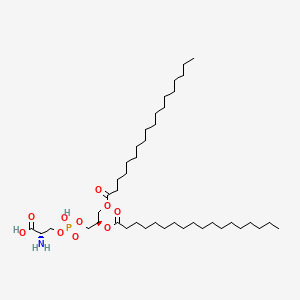51446-62-9
51446-62-9 is a lipid of Glycerophospholipids (GP) class. 51446-62-9 is associated with abnormalities such as Virus Diseases, Infection, Bacterial Infections, Communicable Diseases and Exanthema. The involved functions are known as Phagocytosis, Obstruction, Binding (Molecular Function), targeting and inhibitors. 51446-62-9 often locates in Head, Clone, Cell membrane, Cell surface and host. The associated genes with 51446-62-9 are Homologous Gene, Orthologous Gene, Fusion Protein, ETV3 gene and Amino Acids, Basic. The related lipids are Phosphatidylserines, Lipopolysaccharides, 1-palmitoyl-2-oleoylphosphatidylethanolamine, beta-amyrin and Membrane Lipids.
References related to genes published in Others
| PMID | Journal | Published Date | Author | Title |
|---|---|---|---|---|
| 28202633 | J. Lipid Res. | 2017 | Hopiavuori BR et al. | Regional changes in CNS and retinal glycerophospholipid profiles with age: a molecular blueprint. |
| 27932490 | Mol. Biol. Cell | 2017 | Chalat M et al. | C-terminus of the P4-ATPase ATP8A2 functions in protein folding and regulation of phospholipid flippase activity. |
| 27235400 | J. Biol. Chem. | 2016 | Takar M et al. | The Essential Neo1 Protein from Budding Yeast Plays a Role in Establishing Aminophospholipid Asymmetry of the Plasma Membrane. |
| 27015965 | Blood | 2016 | Biswas S et al. | Novel phosphatidylethanolamine derivatives accumulate in circulation in hyperlipidemic ApoE-/- mice and activate platelets via TLR2. |
| 26588566 | Biophys. J. | 2015 | Thukral L et al. | The Molecular Mechanism Underlying Recruitment and Insertion of Lipid-Anchored LC3 Protein into Membranes. |
| 26282427 | Antimicrob. Agents Chemother. | 2015 | Kerrinnes T et al. | Phospholipase A1 modulates the cell envelope phospholipid content of Brucella melitensis, contributing to polymyxin resistance and pathogenicity. |
| 26278183 | Chem. Biol. | 2015 | Henriques ST et al. | The Prototypic Cyclotide Kalata B1 Has a Unique Mechanism of Entering Cells. |
| 25980030 | J. Immunol. | 2015 | Zenarruzabeitia O et al. | The Biology and Disease Relevance of CD300a, an Inhibitory Receptor for Phosphatidylserine and Phosphatidylethanolamine. |
| 25418302 | Biophys. J. | 2014 | Giang H and Schick M | How cholesterol could be drawn to the cytoplasmic leaf of the plasma membrane by phosphatidylethanolamine. |
